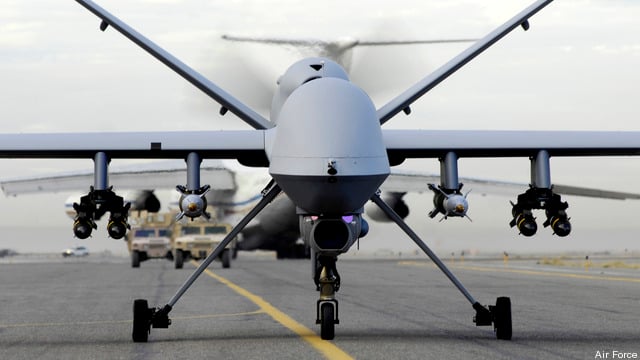
Will Roper
CLARIFICATION: To Add That Roper Is Hopeful Changing Business Models Will Stave Off Worst Case Results
WASHINGTON: Air Force acquisition head Will Roper is worried that without a new approach to aircraft development that incentivizes more companies to participate, the ever-shrinking US defense industrial base may force DoD to nationalize major programs in the not-so-distant future.
“I think it’s really important that we find a new model where there are no big winners, and no big losers, but continual competition,” he told reporters today. “Because if our industrial base collapses any more, we’ll have to nationalize advanced aviation — and maybe other parts of the Air Force that currently aren’t competitive.”
While rushing to say that, as of now, there has not been any internal Pentagon discussion about nationalization of the aerospace industry, he told reporters today: “I don’t think that’s out of the tea leaf reading.”
“It has surprised me in this job that there’s not more concern in the Pentagon about the continual shrinking of the defense industrial base,” he added.
CLARIFICATION BEGINS: Indeed, Roper has been working hard to change to way the Air Force does business in order to try to stave off such a worst-case outcome, with some positive first indications.
“I also am holding out some hope that if we open up the door to do design frequently, and build things in smaller batches that are between X-planes and mass production, that we will eventually encourage an innovative company to cross over into the fence or companies to start up,” he said.
Roper explained that the problem wasn’t that the “defense industrial base has gotten worse,” rather the issues is that “programs are so few and far between.” CLARIFICATION ENDS.
He explained that this reality forces defense companies to acquire “a pretty diversified portfolio” because the only competitions “may be a fighter one year, a satellite the next year, and a helicopter the next year.
“We’ve seen this trend of major acquisitions to get those portfolios diverse enough so that you can deal with the chutes and rapids of few and far between major acquisitions. So that should be a huge concern to us, especially with our research and development dollars in defense only accounting for 20 percent of the total nation’s.”
A shrinking base means less competition; combine with that the fact that innovation now happens primarily in the commercial sector, not the defense sector.
“I don’t have to tell you that, eventually, we will nationalize warfighting capabilities and the defense industrial base, it will happen by necessity — by national security necessity, but I don’t think that that’s a fait accompli,” he said.
Digital Century Series
That concern is one of the reasons Roper is betting on the Digital Century Series concept as the Air Force considers its development plans and procurement strategy for the highly classified Next Generation Air Dominance (NGAD).
“My hope in the Digital Century Series is to stabilize, at least for tactical aircraft, the collapse of our aviation industrial base any further,” he said.
The new Program Executive Office for Fighters and Advanced Aircraft working on those programs has drafted a study to determine whether that concept — where new versions of aircraft are rotated into the fleet every 15 or so years — is actually cheaper than traditional programs, where up front unit costs are low but vendors make bank on modernization and sustainment.
In major acquisition programs where one winner takes all, he explained, “there is no way to tell industry, in a way you can enforce, not to significantly invest — it’s too big of a deal, they have to win. That internal investment is then what creates that strong incentive to lock into the program, to put intellectual property into all different interfaces, no matter how good we are at trying to police it out of the system.”
“The designer always have mechanisms to skirt around our best policy and oversight,” he said wryly, because without being able to ensure future contracts for upgrades and upkeep, the firm wouldn’t have a business case. But for the Air Force, modernizing and sustaining aircraft after year 15 results in increased costs of somewhere between three and eight percent per year, he said.
The idea with Digital Century Series, by contrast, is to break out of this model into one where the up-front price the Air Force pays for new aircraft is essentially the “total price of ownership.” The hope, he said, is that while the up-front unit prices will be higher, the cost over time will be significantly lower than a traditional major program buy. And in fact, he said, Air Force’s “compare and contrast” study of the two different acquisition models so far has found that the Digital Century Series concept is “slightly cheaper.”
“Maybe significantly cheaper,” he added, “but slightly cheaper than a traditional acquisition,” even one leveraging digital engineering to help keep the costs of future modernizations down.
However, Roper said he has now brought in independent experts to “check our assumptions, check our math,” and is awaiting the results of their assessment.
“I think in three weeks, I’ll be able to go from pencil to ink and say whether this is viable or not,” he said.
MQ-9 Reaper and MQ-Next
In the wide-ranging briefing, Roper also touched on the hot-button MQ-9 Reaper replacement effort that has piqued congressional concern. The reason the service is taking a bit of time to study future options, he explained, is the belief that future peer combat will require not just a new unmanned aerial vehicle for ISR/strike — but instead a multi-mission family of drones to do everything from air-to-air missions to ISR/strike to base defense.

Armed MQ-9 Reaper drone.
“We need these UAVs to be true utility players, to use the baseball analogy,” he suggested.
But Roper knows he’s got to keep a close eye on the Hill, because “building a utility player that can meet multiple mission demands is not something that our acquisition system has historically been good at. And we’ve got to get good quickly to convince Congress that this is a good pivot, and I look forward to having those discussions that summer.”
Roper said he met with the development team studying concepts for the “Next Generation UAS ISR/Strike Platform” two weeks ago to discuss everything from how high-end drones could be teamed with relatively inexpensive and attritable ones to how to do “smart automation” that limits the number of people needed to operate them.
“We made the pivot to divest MQ-9 to pivot into high-end warfighting, and we’re gonna have to build new systems for high-end warfighting and teamed systems for high-end fighting. So I think the litmus test for ‘MQ-Next’ is going to be what other letter can we assign to its name because it’s doing a mission other than is ISR strike,” he said, with a chuckle.
“Ones that that jumped to the forefront for me,” he added, “are arming systems with air-to-air weapons, not just air-to-ground, so that you could play a role with forward tac air, but also being able to pull said system back to defend high-value assets that don’t have defensive systems that are able to hold adversary air at risk. I think that would be a wonderful combination.”
Roper said it’s necessary for the Air Force “to explore more than just the MQ-9 mission” of gathering ISR data and striking targets in places like the Middle East, because there simply isn’t enough budget leeway to do otherwise as the service shifts focus to combat with peer competitors.
Lawmakers are concerned that the service doesn’t yet have a solid acquisition strategy for replacing the venerable MQ-9 — a platform that has flown more than 4 million operational flight hours.
Thus there has been a wave of congressional opposition to the Air Force’s decision in its 2021 budget request to begin divesting of the aircraft, and its February stop-order on production by prime General Atomics.
The full House Appropriations Committee today approved its subcommittee’s decision to add $343.6 million for 16 MQ-9s to the Air Force’s budget — with Rep. Ken Calvert noting the importance of the drone to combatant commanders. Report language accompanying the bill highlighted concerns among lawmakers — also voiced by the House and Senate Armed Services Committees — that the Air Force’s replacement effort is moving too slowly could result in a gap in capability.
Roper, however, said that not only can the Air Force have new drones fielded by 2030, but that there should be several iterations of improved platforms developed over the next decade.
“Absolutely we can get there by 2030. In a digitally engineered future,10 years is an eternity. I would hope we could spiral multiple times within that 10 years,” he stressed.
Responses to the Air Force’s June request for information are due July 24, and judging by discussions so far,. vendors are likely to offer a number of approaches.
“I expect to see a lot of high-end tech options in the submissions that are trying to help us do a current mission, other than ISR strike, differently,” he said, noting that if a system can do that, it also makes ISR easier especially in a permissive environment. “If you can do those high-end missions, then I’m willing to hit the ‘I believe’ button,” he said.
On the other hand, he also expects contractors to come in with “a different approach to survivability” — perhaps proposing large quantities of cheap attritable drones; or concepts that team sensor carrying drones with others carrying munitions, Roper said.
“You can imagine, designing things that may not return is a complete cultural shift for us and for industry, but I’ve been pretty pleased with the informal engagements thus far,” he said, “and I expect to see some really creative thinking.”
Air Force picks Anduril, General Atomics for next round of CCA work
The two vendors emerged successful from an original pool of five and are expected to carry their drone designs through a prototyping phase that will build and test aircraft.


























